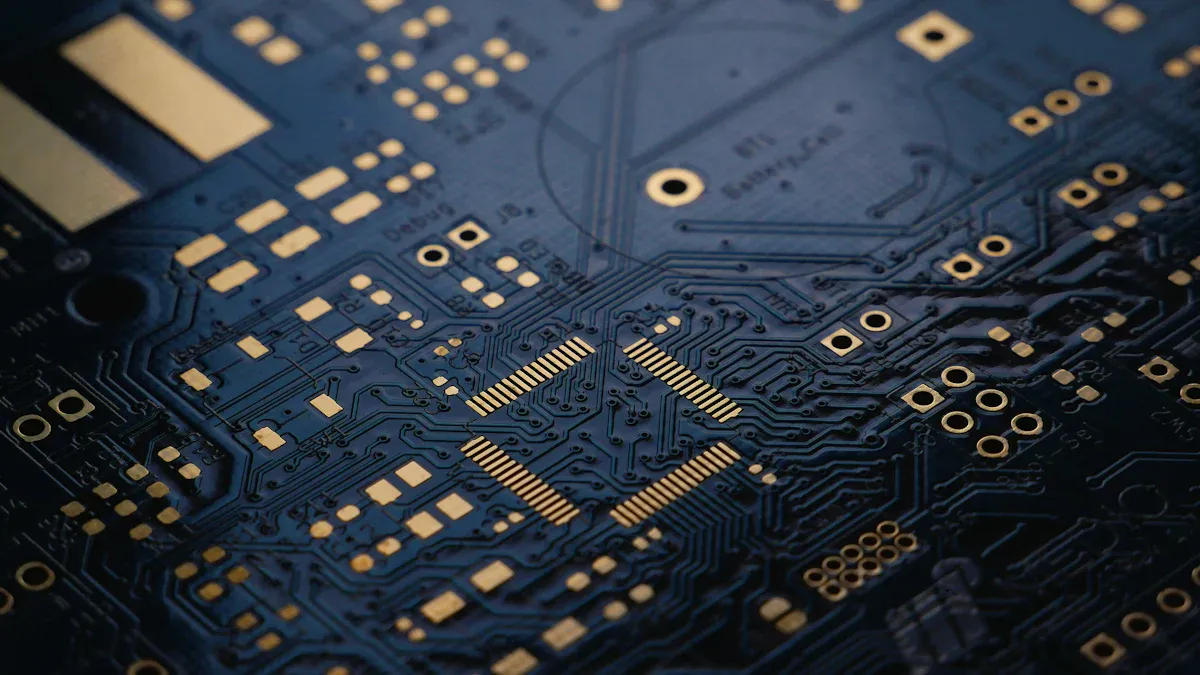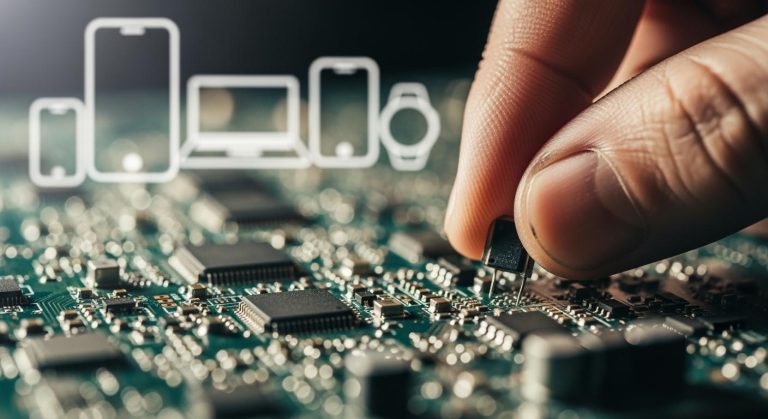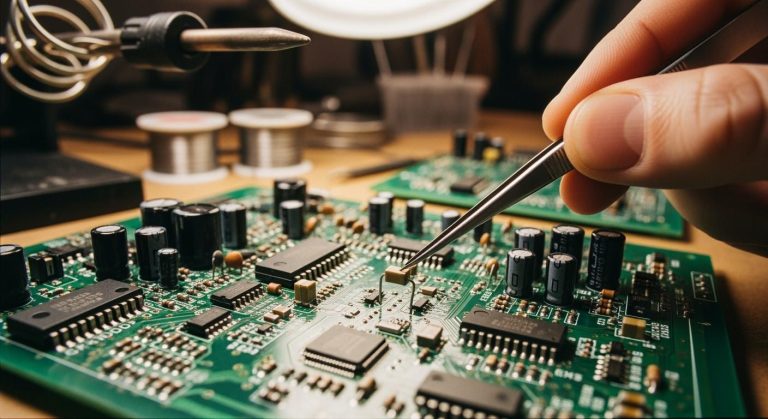You rely on pcba to power devices like smartphones, laptops, and IoT equipment. Unlike a simple PCB, pcba integrates all essential components using advanced techniques such as surface-mount and thru-hole technology. These methods boost reliability for medical and military systems. Advanced testing and miniaturization define modern pcba manufacturing, setting expert pcba contract manufacturer standards and distinguishing leading pcba manufacturers in the industry.
Key Takeaways
- PCBA transforms a bare PCB into a functional device by integrating essential components, ensuring reliable performance in electronics.
- Quality control in PCBA manufacturing is crucial. Advanced testing methods like X-ray and functional testing help catch defects early, ensuring safety and performance.
- Choosing a certified and experienced PCBA manufacturer enhances product reliability and reduces the risk of costly defects and delays.
PCBA Manufacturing and Device Reliability
What Is PCBA?
You interact with electronic devices every day, but you might not realize how much depends on the quality of pcba. Printed circuit board assembly, or pcba, refers to the process of mounting and soldering electronic components onto a bare board. This process transforms a simple board into a functional unit that powers your devices.
A typical pcba contains several key components that enable device operation:
- Diode: Directs current flow in one direction.
- LED: Emits visible light when powered.
- Resistor: Controls the flow of electric current.
- Capacitor: Stores and releases electrical energy.
- Inductor: Stores energy in a magnetic field.
- Switches: Allow or prevent current flow.
Each component plays a specific role in the circuit. When you use a device, these parts work together to deliver reliable performance.
PCB vs. PCBA
You might wonder about the difference between a pcb and a pcba. A pcb is the foundation—a flat board made from insulating material with conductive pathways etched onto its surface. It provides the structure for mounting components but cannot function on its own.
Pcba manufacturing takes this foundation and builds upon it. The process involves several steps:
- Solder paste application: Technicians apply solder paste to the pcb.
- Component placement: Machines or skilled workers place components onto the board.
- Soldering: The assembly process secures components using heat.
- Inspection: Experts check the board for defects and proper function.
This transformation is essential. Without assembly, the board remains inert. With assembly, you get a working device.
The complexity of pcb assembly far exceeds that of pcb fabrication. Pcba manufacturing requires precise calibration, especially for fine-pitch components. High-density designs and multi-layer boards add to the challenge. These factors increase both the cost and time required. For example:
| Item | Cost (Approx.) |
|---|---|
| PCB Manufacturing Cost | $0.50 per board |
| Assembly Cost (US) | $0.05 to $0.10 per placement |
| Total PCBA Cost | Several times higher than PCB cost alone |
You see that pcba manufacturing involves more steps, greater complexity, and higher investment than simple pcb production.
Why PCBA Is the Heart of Electronics
Pcba stands at the center of modern electronics. It serves as the foundation for functional devices, transforming design concepts into intelligent, high-performance products. Pcba manufacturing integrates various components into a single system, ensuring accurate electrical signal flow between chips, sensors, and power circuits.
You benefit from this integration every time you use a smartphone, medical device, or IoT sensor. High-density designs and multi-layer assemblies enable miniaturization, making your devices smaller and more powerful.
The reliability of your device depends on the quality of pcb assembly. Pcba manufacturers use advanced testing methods to ensure performance and safety. These methods include:
| Testing Method | Contribution to Reliability |
|---|---|
| Visual Inspection | Identifies surface defects early |
| X-ray Inspection | Detects internal defects not visible to the naked eye |
| Functional Testing | Ensures the device operates as intended under normal conditions |
| Environmental Testing | Assesses performance under extreme conditions |
| Reliability Testing | Evaluates long-term performance and durability |
Reliability testing and failure analysis help pcba manufacturers identify and resolve issues before products reach you. This process ensures compliance with industry standards and regulatory requirements. When pcba contract manufacturer teams address defects such as plating roughness, solder joint cracking, or inadequate thermal design, they prevent failures that could disrupt your experience.
Poor pcba manufacturing can lead to high defect rates, production delays, and costly rework. If defective boards reach consumers, companies risk negative feedback and product recalls. By choosing experienced pcba manufacturers, you ensure that your devices meet quality standards and deliver consistent performance.
PCBA Manufacturing Process and Quality Control
Design and Fabrication Steps
You start the journey of pcb assembly with a detailed design and fabrication process. Each step in this process shapes the quality and reliability of the final printed circuit board assembly. Here is how the typical pcb assembly process unfolds:
- File Review: You review customer files for manufacturability and spot any flaws.
- Material Selection: You choose base materials and panel sizes for the pcb.
- Inner-layer Processing: You develop, etch, and strip the inner layers.
- Lamination: You stack and press the layers together.
- Drilling: You drill holes for vias and clean them for copper plating.
- Outer-layer Processing: You create final copper patterns on the outer layers.
- Solder Mask and Silk Screening: You apply a protective solder mask and print the silkscreen.
- Final Inspection: You inspect the board for quality and conformity.
Your choices during the design phase directly impact the reliability of the pcb assembly. The table below shows how specific design practices influence the final product:
| Design Practice | Impact on Reliability |
|---|---|
| Proper trace width | Ensures current handling without overheating. |
| Controlled impedance | Maintains high-speed signal quality. |
| Thermal vias and copper pours | Helps dissipate heat effectively. |
| Component spacing | Prevents arcing and improves manufacturability. |
| Isolation between analog and digital | Prevents noise interference. |
You see that every decision, from trace width to component spacing, plays a role in the performance and safety of your pcb assembly.
Assembly and Automation
You move from fabrication to the assembly phase, where automation now dominates the pcb assembly process. Automated pick-and-place machines handle the precise placement of components, transforming what was once a labor-intensive task into a highly efficient operation. These machines boost throughput and accuracy, especially as you deal with complex, high-density boards.
You also rely on automated inspection systems, such as Automated Optical Inspection (AOI) and X-ray inspection, to catch defects early. Robotic arms with artificial intelligence further optimize the assembly process, ensuring rapid and precise component placement.
Manual testing can vary depending on the skill and attention of the technician, but automated testing ensures consistent, accurate results. Test scripts and programmed procedures perform the same checks across all units, reducing variability and enhancing product reliability.
Recent advancements in pcb assembly include increased reliance on process automation, digital twin technology for simulation, IoT integration for real-time monitoring, and AI-driven decision-making. These technologies not only enhance productivity and speed but also reduce labor costs and assembly errors. Automated Optical Inspection systems, for example, use advanced cameras and software to identify defects quickly, maintaining high-quality standards throughout the pcb assembly process.
Miniaturization adds another layer of complexity. You must achieve placement accuracy within ±5 µm for tiny components and use precise stencils for solder paste application. Dense layouts limit rework options, so you need advanced technologies and stringent quality control to prevent damage during assembly.
Testing for Performance
You cannot overlook the importance of testing in the pcb assembly process. Rigorous testing ensures that each printed circuit board assembly meets performance and safety standards. The most common tests include:
| Test Type | Purpose | Equipment Needed |
|---|---|---|
| Pressure test | Test circuit board’s withstand voltage ability | Withstand voltage tester |
| Leakage current test | Check if leakage current is within requirements | Leakage current tester |
| Salt spray test | Check corrosion resistance of the circuit board | Salt spray tester |
| Impedance test | Verify if circuit board lines work properly | Ohmmeter |
| Vibration test | Detect if circuit board can withstand vibrations | Vibration meter |
You use non-contact testing methods to avoid issues like poor contact and probe damage. These methods prevent mechanical pressure that could harm sensitive products, ensuring precise evaluation and greater reliability. Quality control at each stage of pcb assembly helps you catch defects early, prevent early-life failures, and ensure compliance with international standards. By standardizing processes and leveraging advanced inspection techniques, you enhance the reliability of every pcb assembly you produce.
Role of PCBA Manufacturers
You depend on experienced pcba manufacturers to deliver reliable electronics manufacturing services. These manufacturers must comply with strict international standards, such as ISO 9001 for quality management, IPC-A-610 for assembly acceptability, and RoHS for environmental safety. The table below highlights some of the most widely adopted standards:
| Standard | Description |
|---|---|
| IPC-A-610 | Acceptability criteria for electronic assemblies, including PCBs, components, and solder joints. |
| IPC-6012 | Quality requirements for rigid PCBs, covering performance specifications and testing methods. |
| IPC-J-STD-001 | Focuses on soldering processes and requirements for electronic assemblies. |
| IPC-2221/2222 | Guidelines for design and documentation in PCBA manufacturing. |
| IPC-A-600 | Standards for surface mount technology. |
| IPC/WHMA-A-620 | Standards for wire harness assembly. |
| IPC-CH-65 | Guidelines for cleanliness and contamination control in PCBA manufacturing. |
When you select a pcba contract manufacturer, you should look for certifications, proven workmanship, and clear communication. The table below outlines key criteria:
| Criteria | Description |
|---|---|
| Certifications & Compliance | Essential for demonstrating alignment with industry requirements, including QMS standards like ISO 9001, AS9100, and ISO 13485. |
| Workmanship | Compliance with industry standards such as IPC-A-610 and J-STD-001 ensures quality performance expectations are met. |
| Communication | Clear communication with the manufacturer helps in better design and production planning, leading to improved quality and efficiency. |
You should collaborate with your manufacturer early in the design phase. This allows you to communicate your requirements and leverage their expertise to optimize pcba processes and improve production efficiency. Choosing a low-quality manufacturer can lead to product failures, increased costs, and damage to your brand reputation. For high-reliability applications, you must prioritize quality and compliance over cost savings.
Advancements in pcba manufacturing address miniaturization challenges, enable high-speed data transmission, and improve thermal management. These improvements support the performance of next-generation electronic devices and help you meet the demands of a rapidly evolving market.
By focusing on quality at every stage of the pcb assembly process, you ensure that your products remain reliable, efficient, and competitive in the world of electronics manufacturing services.
You depend on pcba to ensure your devices work reliably and safely. Each stage, from design to testing, shapes the quality of high-quality pcbas. The table below highlights why you should value pcba in electronics:
| Factor | Impact on Devices |
|---|---|
| pcba quality | Boosts performance |
| pcba process control | Reduces defects |
| pcba complexity | Drives innovation |
| pcba manufacturer | Delivers trusted results |
You see that pcba stands at the core of every advanced device.
FAQ
What is the main difference between pcba and PCB?
You see a PCB as a bare board. A pcba includes all the mounted components, making it ready for use in electronic devices.
Why does pcba quality matter for your device?
You depend on pcba quality for device reliability. High-quality pcba reduces failures, improves performance, and ensures your electronics meet industry standards.
How do you choose a reliable pcba manufacturer?
Tip: You should check certifications, review customer feedback, and confirm advanced testing capabilities. Reliable pcba manufacturers help you avoid costly defects and delays.
What testing methods do pcba manufacturers use?
Manufacturers use visual inspection, X-ray, and functional testing. These methods help you verify that each pcba meets strict quality and safety requirements.
Can pcba manufacturing support miniaturized devices?
You benefit from advanced pcba processes that support miniaturization. Automated assembly and precise placement allow you to create smaller, more powerful devices.
How does automation improve pcba assembly?
Automation increases speed and accuracy in pcba assembly. You get consistent results, fewer errors, and higher throughput for complex electronic products.
What standards should your pcba meet?
| Standard | Purpose |
|---|---|
| IPC-A-610 | Assembly acceptability |
| ISO 9001 | Quality management |
| RoHS | Environmental compliance |
You should ensure your pcba meets these standards for best results.























